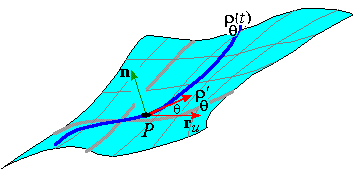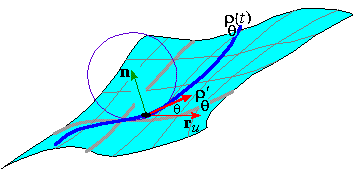Normal Curvature
If P is a point on an orientable surface S and if r( u,v) is an orthogonal parameterization of a
coordinate patch on S containing P, then there is (p,q) such that r( p,q) = P. Thus, for each q in [ 0,2p] , the curves
|
rq(t) = r( p + tcos(q), q + tsin(q) ) |
|
pass through P (i.e., rq( 0) = r( p,q) = P ) and the tangent vectors
rq' (0) point in a different direction in the tangent
plane to S at P.
Indeed, every direction in the tangent plane is parallel to
rq' ( 0) for some q.
Consequently, the curvatures of rq( t)
at P represent all the different ways that the surface "curves away" from
the tangent plane at P. Correspondingly, we define kn( q) to be the component of the curvature of rq( t) at P in the direction of the unit normal
In particular, the normal curvature satisfies v2 kn( q) =
rq'' (0) · n, so that
|
kn( q) = |
rq'' ( 0) · n
|| rq' (0) ||2
|
|
| (3) |
The unit surface normal n is not necessarily the same as the unit
normal N for the curve. They may point in opposite directions
or even be orthogonal - e.g., the normal N to a curve in the xy-plane is in the xy-plane itself yet n = k for the xy-plane. Thus, the normal curvature kn(q) is a
measure of how much the surface is curving rather than how much the curve is
curving.
That means that kn( q) may
be positive, negative, or even 0 - e.g., the normal curvature of the xy-plane is 0 even though there are curves in the xy-plane with nonzero
curvature.
EXAMPLE 3 Use (3) to find the normal
curvature kn(q) for the cylinder
|
r( u,v) =
á cos( u) ,sin(u) ,v
ñ |
|
at the point r( 0,0) = ( 1,0,0) .
Solution: The curves rq( t) = r( tcos(q), tsin( q)) are given by
|
rq( t) =
á cos( tcos( q) ) ,sin( tcos( q)) ,tsin( q)
ñ |
|
Differentiation with respect to t leads to
|
|
|
|
á -sin( tcos(q) ) cos( q) ,cos( tcos(q) ) cos( q) ,sin( q)
ñ |
| |
|
|
á -cos( tcos( q) ) cos2( q) ,-sin(tcos( q) ) cos2( q),0
ñ |
|
|
so that at t = 0 we have
|
|
|
|
á -sin( 0) cos( q) ,cos( 0) cos(q) ,sin( q)
ñ =
á0,cos( q) ,sin( q)
ñ |
| |
|
|
á-cos( 0) cos2( q) ,-sin( 0)cos2( q) ,0
ñ =
á -cos2( q) ,0,0
ñ |
|
|
The partial derivatives of r( u,v) are
|
ru =
á -sin( u) ,cos( u),0
ñ , rv =
á 0,0,1
ñ |
|
which are both unit vectors. It follows that ru(0,0) =
á 0,1,0
ñ = j and rv =
á 0,1,0
ñ = k. Thus,
|
n = ru( 0,0) ×rv(0,0) = j×k = i |
|
Since
rq' ( 0) is a unit vector, we have
|
kn( q) = |
rq'' ( 0) ·n
|| rq' ( 0) ||2
|
= |
á-cos2( q) ,0,0
ñ ·i
1
|
= -cos2( q) |
|
That is, if we slice the cylinder along the vector v( q) through a normal to the surface at a point P, then the curvature
at P of the curve formed by the intersection is kn (q) = -cos2(q) . To illustrate, consider that in the applet below each blue curve is a
circle with radius 1/cos2(q).
|
|
| The angle is θ = thet | °. | |
The curvature is κ n(θ) = -ax^2 |
|
|
|
Because the normal curvature kn( q) is a real-valued continuous function over q in [0,2p] , there is a largest k1 and a smallest k2 curvature at each point. The numbers k1 and k2
are known as the principle curvatures of the surface r( u,v) .
In example 3, the largest possible curvature is k1 = -cos2( p/2) = 0 in the vertical direction, and the
smallest possible curvature is k2 = -cos2( 0) = -1
in the horizontal direction.
The average of the principal curvatures is called the Mean curvature of the surface and is denoted by H. It can be shown that
if C is a sufficiently smooth curve, then the surface with C as its
boundary curve that has the smallest possible area must have a mean
curvature of H = 0. For example, consider two parallel circles in 3 dimensional space.
The catenoid is the surface connecting the two circles that has the least surface
area, and a catenoid
also has a mean curvature of H = 0.
Because they also have the least surface area for their given boundary., surfaces with a mean curvature of H = 0 are called minimal surfaces. This
and other properties mean that minimal surfaces have a large number of
applications in architecture, mathematics, and engineering.
Check your Reading: Is the normal curvature of the cylinder ever positive?


